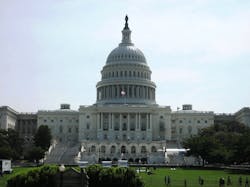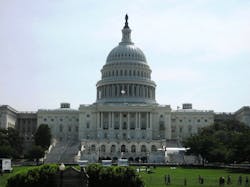Thermal insulation measures gaining momentum on Capitol Hill
CHICAGO — Pipe insulation initiatives for buildings have been gaining a head of “steam,” both through the legislative and code process. Last month, with efforts from International Association of Plumbing and Mechanical Officials (IAPMO) and support from CONTRACTOR magazine — and a strong contingent of industry players — bill H.R. 4801, which calls for the Department of Energy to report on the impact and savings potential of improved thermal insulation systems on both energy and water use for potable water in federal buildings, passed through the House of Representatives.
The next hurdle — Senate approval awaits.
Introduced by U.S. Reps. Adam Kinzinger (R-Ill.) and Jerry McNerney (D-Calif.), H.R. 4801 provides a clear mechanism for the federal government, the single largest consumer of energy in the country, to conserve resources and cut spending in working toward a viable energy strategy for the future.
Pipe insulation proposal seeks change to plumbing codes to save energy, water
“Vast amounts of energy, water and money are needlessly wasted every day by current heating and cooling techniques,” said Dain Hansen, IAPMO’s vice president of Government Relations. “The increased use of thermal insulation in federal buildings would provide a simple and actionable strategy to reduce energy use and cut unnecessary costs, consequently achieving tangible energy efficient results. Additionally, improved insulation measures would have an immense impact on the U.S. economy as a whole, including significant savings for taxpayers, tens of thousands of new jobs, and a considerable reduction in harmful carbon emissions.
“This federal legislation, if adopted and signed into law, will provide sound, quantifiable data to the true and very real energy savings that thermal insulation can achieve within our potable water systems,” added Hansen. “The effects of this bill can also help boost the economy, creating jobs for the installing contractor and in the manufacturing sector.”
A coalition letter sent to representatives Kinzinger and McNerney stated that vast amounts of energy, water and money are needlessly wasted every day by current heating and cooling techniques.
The increased use of thermal insulation in federal buildings would provide a simple and actionable strategy to reduce energy use and cut unnecessary costs, consequently, achieving tangible energy efficient results. Additionally, improved insulation measures would have an immense impact on the U.S. economy as a whole, including significant savings for taxpayers, tens of thousands of new jobs, and a considerable reduction in harmful carbon emissions.
The letter continued: As the single largest consumer of energy in the country, the federal government should do its best to conserve resources and cut spending wherever possible. H.R. 4801 provides a clear mechanism for this to be achieved and is another step towards a viable energy strategy for the future.
Section 1 of H.R. 4801 outlines the House’s action to report on energy and water savings potential from thermal insulation.
“Not later than one year after the date of enactment of this Act, the Secretary of Energy, in consultation with appropriate Federal agencies and relevant stakeholders, shall submit to the Committee on Energy and Natural Resources of the Senate and the Committee on Energy and Commerce of the House of Representatives a report on the impact of thermal insulation on both energy and water use systems for potable hot and chilled water in Federal buildings, and the return on investment of installing such insulation,” the bill states.
The report includes an analysis based on the cost of municipal or regional water for delivered water and the avoided cost of new water; and a summary of energy and water savings, in including short-term and long-term (20 years) projections of such savings.
Plumbing codes
In similar, yet separate initiative news, the United Association of Journeymen and Apprentices of the Plumbing and Pipefitting Industry (UA) and the Natural Resources Defense Council (NRDC) have reached an agreement on a landmark proposal to save energy and water in new buildings.
The two organizations jointly submitted a proposal to IAPMO to require the insulation of hot water piping in new buildings.
“As IAPMO drafts its next set of codes, we recommend insulating hot water piping to reduce the waste of energy and water in hot water systems,” said William P. Hite, General President of the United Association. “This proposal is indicative of the UA’s commitment in construction, service and maintenance practices required for energy efficient green buildings. Throughout the construction industry, there are untapped opportunities to make our buildings and our economy more efficient, and we should seize these opportunities to create good jobs for American workers.”
In a typical, 3-bedroom, 2-bath home, an estimated 12% of all hot-water use is wasted, according to a 2009 analysis led by Robert Hendron of the National Renewable Energy Laboratory (NREL).
Purging at showers, kitchen sinks, and lavatory faucets was responsible for 95% of the estimated total of nearly 3,000 gallons of hot water waste annually. NRDC estimates pipe insulation can reduce this waste of water and energy by 15% to 30%. Of course, many new homes are built with more hot water outlets than the NREL model’s base case, and with hot water distribution systems that are far less efficient.
According to Peter Lehner, executive director at the Natural Resources Defense Council, “This proposal is a commonsense solution to an everyday problem that we can all warm up to. Most of us waste too much time, energy and money waiting for hot water to come out of our faucets and showers. By combining efficient designs, proven energy-saving materials, and skilled labor, we can build smarter buildings that curb this waste and improve the amenity of new buildings. This proposal will not only save homeowners and renters money on their monthly utility bills but also protects our environment by cutting energy and water use.”

